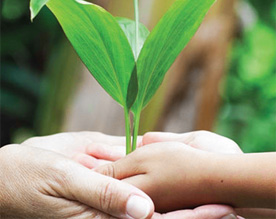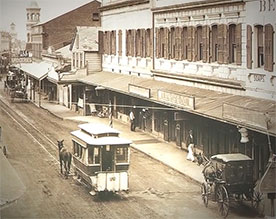
- Our Vision & Commitment
- Our History
- Performance Scorecards and Metrics
- Our Leadership Team
- Newsroom
- Awards & Recognition
- Power Facts
- Innovation
- Affiliate Transactions
Our Logo
Our company logo is a symbol of where we've been, who we are, and where we're going. It represents our rich history, our commitment today, and our vision for the future. View our logo story
Our History and Timeline
Hawaiian Electric serves 95 percent of Hawaii's 1.4 million residents on the islands of Oahu, Maui, Hawaii, Lanai and Molokai. Established in 1891, Hawaiian Electric is committed to empowering its customers and communities by providing affordable, reliable, clean and sustainable energy.
The demand for power that has fueled the growth of the Hawaiian Islands has been met by Hawaiian Electric for well over a century. And as the next millennium unfolds, the company is committed to providing quality service and seeking clean local energy sources to power generations of Hawaii families and businesses to come.
Hawaiian Electric
1881: The Birth of Hawaiian Electric
- King Kalakaua meets Thomas Edison at his home in New York to see the incandescent light bulb in 1881.
- Iolani Palace becomes one of the world's first royal residences to be lit by electricity in 1886.
- Honolulu streets are lit by electricity for the first time in 1888.
- Hawaiian Electric Company, Ltd. is incorporated on Oct. 13, 1891.
- Alakea Power Plant is dedicated and placed into service in 1894.
- In 1901, ice and cold storage are added to our services.
- Hawaiian Electric establishes service to the windward side of Oahu by stringing an 11,000 volt line over the Pali to service a wireless telegraph company at Heeia in 1914.
- The legislature grants Hawaiian Electric the right to supply power to the entire island in 1915.
- Hawaiian Electric's King Street building opened for business on July 25, 1927.
- Groundbreaking at Waiau Power Plant in 1937.
- The first unit at the Waiau Generating Station goes online in 1938.
- Hawaiian Electric celebrates its 50th anniversary in 1941.
- Workers safely shut down the Waiau Power Plant while under fire from Japanese war planes on December 7, 1941.
- In 1954, the Leslie A. Hicks Power Plant in downtown Honolulu becomes operational.
- The first 138 kV lines are strung from Waiau over the Koolau range. The Pali tunnels and a new highway open Windward Oahu to development in 1958.
- The first unit at Kahe Power Plant goes online in 1963.
- Hawaiian Electric stock is publicly traded for the first time in 1964.
- Hawaiian Electric acquires Maui Electric Company on Nov. 1, 1968.
- Hawaiian Electric acquires Hawaii Electric Light Company on Feb. 1, 1970.
- Hawaiian Electric Industries is formed to diversify the company's business base. Hawaiian Electric becomes a subsidiary of Hawaiian Electric Industries in 1983.
- Hawaiian Electric Renewable Systems (HERS), an HEI subsidiary, builds the Makani Moae windfarm in Kahuku in 1985.
- Maui Electric acquires Lanai City power plant in 1988, and Molokai Electric Company in 1989.
- Hawaiian Electric contracts for the first time with three independent power producers in 1989: The Honolulu Program of Waste Energy Recovery (H-Power), Kalaeloa Partners L.P., and Applied Energy Services, Barbers Point, Inc. (AES).
- Puna Geothermal Venture begins providing power to Hawaii Electric Light in 1993.
1995: Changing to Meet Customers' Needs through Energy Solutions
- Hawaiian Electric wins the Edison Award in 1995 - the electric utility industry's highest honor - for promotion of energy-efficient heat pump electrotechnology in Hawaii.
- The Electric Kitchen, which was filmed in the King Street Auditorium, starts airing as a televised cooking show in 1995.
- Hawaiian Electric begins offering energy efficiency "Energy$olutions" rebate programs, including the nation's largest residential solar water heating program in 1996.
- Hawaiian Electric unveils its new e-bill service allowing customers to view and pay their electric bills via the internet in 1999.
2000: Powering our Communities
- Hawaiian Electric is named Aloha United Way's Corporation of the Year, 2001.
- American Lung Association awards Hawaiian Electric with the Mauli Ola (Breath of Life) award for environmentally responsible operation of our power plants in 2003.
- Hawaiian Electric is recognized as the 2004 business leader for "Commitment to the Community" by Pacific Business News.
- 6,000 residential customers enrolled for the Energy Scout load-control program in 2005.
2006: Building Energy through Partnerships
- Hawaiian Electric completes installation of Hawaii's longest 46-kv underground and undersea sub-transmission cables beneath the ocean floor from Ford Island to the shores of Pearl Harbor in 2006.
- In 2008, the state of Hawaii and U.S. Department of Energy sign an MOU to collaborate on the reduction of Hawaii’s heavy dependence on fossil fuels. That same year in October, the Hawaiian Electric Companies and parent company HEI sign a comprehensive Clean Energy Agreement with the state and Division of Consumer Advocacy of the Department of Commerce and Consumer Affairs to uphold the goals and objectives of the Hawaii Clean Energy Initiative, which aims to achieve 70% of the state’s electricity and ground transportation needs from clean energy sources by 2030.
- Eighty two of Hawaii Electric Light's diesel fleet vehicles complete the switch from straight diesel to a more environmentally-friendly biodiesel mix in 2008.
- Hawaiian Electric's 110-MW Campbell Industrial Park Generating Station, fueled by renewable biodiesel, goes online in 2009.
- After 13 successful years, Hawaiian Electric transfers its Energy$olutions programs to the PUC’s third-party administrator.
- Hawaiian Electric and Maui Electric Company are honored for Solar Energy Adoption by the Solar Electric Power Association in 2012.
- In 2012, Going Solar, online solar resource center, was launched to provide customers information on choosing a contractor, financing, siting, and sizing photovoltaic and more.
- Hawaiian Electric deactivates Honolulu Power Plant on Jan. 31, 2014.
- Hawaiian Electric pledges support of the state's new goal of 100 percent renewable energy by 2045, the most aggressive clean energy goal in the country in 2015.
- Hawaiian Electric opens the first utility-owned and operated DC Fast Charger for electric vehicles on Oahu at Dole Plantation in 2015.
- At the end 2016, about 15 percent of all residential and commercial electric customers have PV systems – nearly 20 times the national average.
- In 2018, the 50-MW Schofield Generating Station – a collaboration between the U.S. Army and Hawaiian Electric – begins operations as a fuel-flexible, highly efficient plant that can keep critical infrastructure running during a major outage affecting the Oahu grid.
- In 2019, Clearway Energy Group brings online three grid-scale solar power projects (Kawailoa, Waipio, and Mililani) totaling 110 megawatts (MW).
- Hawaiian Electric’s 20-MW West Loch Solar Project, a collaboration with the U.S. Department of the Navy, goes online in 2019 at Joint Base Pearl Harbor-Hickam West Loch Annex.
- In 2019, Hawaiian Electric approves the state’s first-ever community solar project for construction, a 270-kilowatt facility called Mililani Tech Solar I.
- Hawaiian Electric Company named 2019 “Utility of the Year” by Utility Dive, a leading energy industry publication.
- Hawaiian Electric pledges an all-electric passenger fleet by 2035, joining a nationwide collaborative commitment in 2020 to the electrification of transportation.
- At the end of 2020, Hawaiian Electric achieves a 35% RPS, surpassing its year-end goal of 30%.
- In support of electrification of transportation, Hawaiian Electric debuts “The Electric Garage” in 2021 as a resource for navigating the evolving electric ground transportation industry in Hawaii.
- On Nov. 5, 2021, Hawaiian Electric announces goal to reduce carbon / greenhouse gas emissions 70% by 2030 and commits to net zero carbon emissions by 2045.





